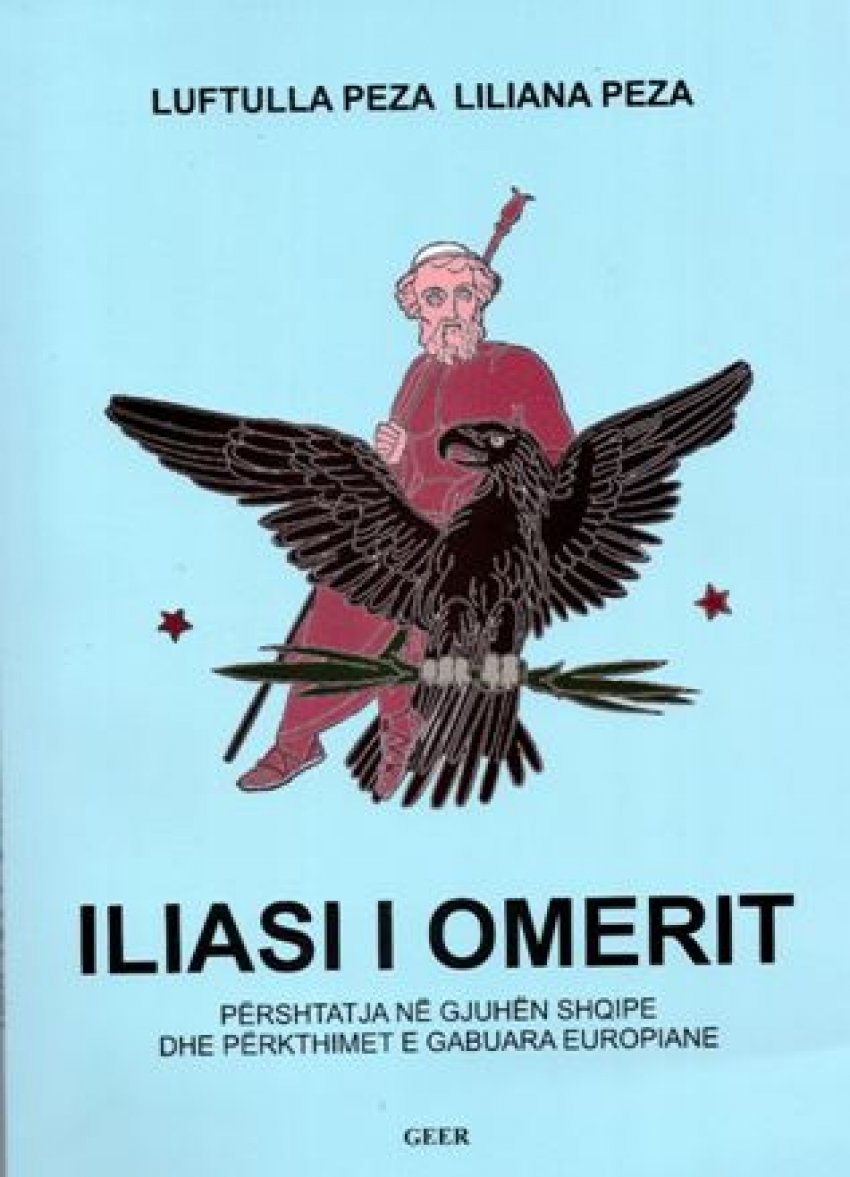Pashtriku, 15 mars 2021: Libri i ri “ILIASI I OMERIT PËRSHTATJA NË GJUHËN SHQIPE DHE PËRKTHIMET E GABUARA EUROPIANE” i autorëve L.PEZA dhe L.PEZA sapo doli nga shtypi.
Iliasi i Omerit është vepra më e vjetër letrare në letërsisë europiane dhe perëndimore dhe është vlerësuar nga rrethet shkencore me notat më të larta si vepra e parë letrare, me ndikim të madh në të gjithë shoqërinë njerëzore.
Në Ilias përshkruhen ngjarje nga Lufta e Trojës rreth vitit 1200 p.e.s., midis qytet-shteteve pellazge të Trojës me aleatët e saj dhe sulmuesve akej me aleatët e tyre. Në vargjet e poemës përshkruhen ngjarje të ndryshme heroike, heroj dhe veprimet e perëndive të Olimpit me Zeusin Pellazg në krye, duke mbështetur herë njerën e herë tjetrën palë. Edhe Omeri, autori i të dy poemave epike, Iliasit dhe Odisesë, vlerësohet si poeti më i madhe i të gjithë kohrave.
Ballina e librit paraqét Omerin me qeleshe dhe me shkop në dorë dhe para tij qëndron shqiponja krahëhapur, që me këmbë shtërngon rrufetë. Shqipja me rrufetë në këmbë, përfaqëson Zeusin Pellazg, prandaj shqiptarët me origjinë pellazgjike, duke qenë bij të Zeusit/Shqipes, që në lashtësi kanë marrë “SHQIPËTARË”.
Në librin e ri vërtetohet plotësisht, që Iliasi dhe Odisea të Omerit janë librat e parë në gjuhën shqipe dhe Omeri i përket racës së lashtë pellazgo/shqiptare. Provat për këtë i gjejmë në vetë këto vepra:
Ne kemi përshtatur disa pjesë të poemës së Iliasit nga gjuha e lashtë pellazge në gjuhën shqipe. Fjalët janë po ato, vetëm se herë janë të bashkuara e herë të shkurtuara. Emërtimi i “ILIAS” ka dy fjalë: ILI + As = ILI (Ylli), mbreti trojan, që themeloi Trojën rreth vitit 3000 p.e.s., AS = Asht.
Kënga e parë fillon me fjalët me alfabetin pellazg:
μῆνιν ἄειδε θεá½° = menin a e i dhe the a = menin a ja dhe the a.. Odisea e Omerit fillon me fjalët: ἄνδρα μοι Eννεπε = andra moi ennepe = andra moj më nep…
Në këtë mënyrë vërtetohet plotësisht në librin tonë të ri, që të dyja poemat e Omerit janë të shkruara me alfabetin pellazg në gjuhën pellazge dhe kuptohen vetëm me gjuhës shqipe, si pasardhëse e saj.
Prandaj libri i ri duhet të jetë në të gjitha shtëpitë shqiptare, sepse i jep krenari racës sonë.
Omeri është autori i parë në histori, që na e jep mjaft të qartë, që Zeusi dhe Dodona janë pellazgjike: “Ζεῦ ἄνα Δωδωναε Πελασγικá½²” / “Zeusi është pjesë e Dodonës Pellazgjike”, Ilias, kënga 16, vargu 233.
***
Vitet e fundit kanë dalë në dritë katër çeshtje themelore, që lidhen me Iliasin e Omerit dhe që përbëjnë thelbin e këtij libri:
1-Nga analiza e disa pjesëve me vargje nga këngë të ndryshme të Iliasit të Omerit rezulton se të gjitha fjalët e vargjeve omerike përbëhen nga fjalë të lashta, që kanë kuptimin vetëm në gjuhën e sotme shqipe. Këto fjalë i përkasin gjuhës së lashtë pellazge, që ka zotëruar Europën dhe Mesdheun gjatë kohës së vonë të gurit, bronzit dhe në kohën kur u shkrua Iliasi i Omerit, që sot mbijeton vetëm në gjuhën shqipe. Kështu është vërtetuar plotësisht se Iliasi i Omerit është vepër letrare madhore, e shkruar në gjuhën pellazge, që është forma më e lashtë e gjuhës shqipe.
2-Asnjëri nga përkthimet e Iliasit të Omerit, që ne kontrolluam, filluar nga përkthimi më i vjetër në gjuhën latine dhe përkthimet në gjuhët e tjera: shqipe, greke, anglisht, frengjisht, gjermanisht, italisht, spanjisht, rumanisht, rusisht, çekisht, polonisht, kroatisht, serbisht, estonisht dhe turqisht, nuk mund të quhen “përkthime” të Iliasit të Omerit, sepse përmbajtja e këtyre “përkthimeve” nuk përputhen me përmbajtjen e origjinalit të kësaj vepre të Omerit. Kjo ka ndodhur nga fakti, sepse asnjeri nga përkthyesit e Iliasit të Omerit nuk e ka njohur gjuhën e Omerit. Për këtë arsye përkthyesit nuk kanë përkthyer vargjet e Omerit, por kanë përkthyer vargje të tjera nga përkthime në gjuhë të ndryshme, të paraqitur si vargje të Iliasit të Omerit.
3-Edhe përkthyesit grek nuk kanë përkthyer vargjet nga teksti i Omerit, por vargje përkthimesh të tjera në gjuhë të ndryshme, paraqitur sikur kanë qenë përkthime të vargjeve të Iliasit të Omerit. Kjo ka ndodhur, sepse përkthyesit grekë nuk e njohin gjuhën e Omerit. Kështu bien poshtë mithi grek, që gjithë kohën e ka trajtuar Iliasin e Omerit si “vepër letrare në gjuhën greke” dhe Omerin poet grek. Omeri dhe autorët e tjerë antikë si Herodoti, por edhe të mëvonshëm, asnjëherë nuk i përmendin grekët në tekstet e tyre, sepse në kohën e tyre grekët ende nuk kishin ardhur në rajonin e Egjeut. Grekët kanë ardhë në rajonin tonë gjatë shekullit të parë p.e.s., kur edhe përmenden për herë të parë dhe morën emrin nga pushtuesit romak.
4-Për të shkruar Iliasin, nga Omeri, është përdorur alfabeti pellazg, i njohur në Ilirikun Qendror qysh gjatë gurvonit. Alfabeti i lashtë pellazgjik gjatë peiudhës së hekurit, mijëvjeçarit të fundit p.e.s., u përshtat nga pothuajse të gjithë popujt mesdhetarë me origjinë pellazgjike, për të shkruar gjuhën e tyre: popujt e gadishullit Ilirik: ilirët, epirotët, dardanët, maqedonët, thrakët, dakët, paeonët dhe arvanitët; popujt e Azisë së Vogël: lidët, frigët, likët, karianët etj.; në Apenine: etruskët, mesapët, venetët, retët, kamunikët, lepontikët etj. Lidët e kanë shkruar gjuhën e tyre, mjaft mbishkrime ruhen në gjuhën e Lidisë së lashtë. Fillimisht alfabeti i lashtë i Lidisë është përdorur për të shkruar vargjet e Iliasit, më pas regullime janë bërë në Athinë dhe Aleksandri. Athina në këtë kohë ka qenë banuar nga arbanitë, ilirë, maqedonë, dardanë, thrakë etj.
Në Esmyrna të Jonisë, mbretëria e Lidisë dhe më pas në Athinë dhe Aleksandri, gjatë shekullit të 8 p.e.s. ky alfabet u përdor gjerësisht me plotësime dhe zëvendësimet e nevojshme. Nga arvanitët grekët e kopjuan arfabetin pellazg, që e paraqesin, sikur është zbulim i tyre.
Para kulturës europiane shtrohet detyra tepër e rëndësishme dhe urgjente:
Iliasi i Omerit duhet të përshtatet fillimisht i plotë në gjuhën shqipe dhe më pas të përkthehet në gjuhët e huaja, për ti shërbyer plotësisht qytetërimit modern. Për këtë duhet të ngrihet një redaksi e përshtatshme, që të merret me përkthimin dhe redaktimin në gjuhën shqipe dhe në gjuhën angleze.
Libri i ri ka 162 faqe formati A4, ka figura dhe kushton 2000 lekë/18 Euro. Mund të kontaktoni autorët në messenger ose e-mail:[email protected].

***
HOMER’S ILIAD IS OLDEST BOOK IN ALBANIAN AND EUROPEAN LANGUAGE
The new book “HOMER’S ILIAD, ADAPTATION TO THE ALBANIAN LANGUAGE AND WRONG EUROPEAN TRANSLATIONS” of authors L.PEZA and L.PEZA just came out of the press.
Homer’s Iliad is the oldest work written in European literature and as such has been praised by scientific circles with the highest grades. Iliad handles high-level artistic events from the Trojan War around 1250 BC between the Pelasgian city-states of Troy and its allies and the attacking Achaeans on the other with their allies. The poem’s verses accurately describe the various heroic events, battle heroes, and the behavior of the Olympian gods with Pelasgian Zeus at the center, supporting one or other war hero at a time.
The front of the book presents Homer with the Albanian cap and a stick in his hand and in front of him stands the eagle with open arms, which shakes the lightning with its feet. The eagle with lightning on his feet, represents Pelasgian Zeus and the Albanians of Pelasgian origin, being sons of Zeus / Shqipe (Eagle) who in ancient times took the name “bij të shqipes, sons of the eagle”, “SHQIPËTAR/ ALBANIANS”.
Now the book fully proves that Homer’s Iliad and Odyssey are the first books in the Albanian language and Homer belongs to the ancient Pelasgian / Albanian race. Evidence for this is found in these works themselves:
We have adapted some parts of Iliad’s poem from the ancient Pelasgian language into Albanian. The words are the same, only sometimes they are joined and sometimes shortened.
The name “ILIAS” has two words: ILI + As = ILI (Star), the Trojan king, who founded Troy around 3000 BC, AS = Asht = IS. The first song begins with the words with the Pelasgian alphabet:
μῆνιν ἄειδε θεá½° = menin a e i dhe the a = menin a ja dhe the a.. = the anger you said gave you… Omer’s Odyssey begins with the words:
ἄνδρα μοι Eννεπε = andra moi ennepe = andra moj më nep… = give me my dream.
This book should be in all Albanian homes, because it gives pride to our old race.
Homer is the first author in history, which gives us quite clear, that Zeus and Dodona are Pelasgian: “Ζεῦ ἄνα Δωδωναε Πελασγικá½²” / “Zeus is part of the Pelasgian Dodona”, Iliad, song 16, verse 233.
But four key issues have come to light in recent years, which constitute the essence of this book:
1-The analysis of some verses from different songs of Iliad of Homer shows that all the words of the verses consist of ancient words, which have the meaning only in today’s Albanian language. These words belong to the ancient Pelasgian language, which possessed Europe and the Mediterranean during the late Stone and Bronze Age and which today survives only in Albanian. Thus it is fully established that the Homer’s Iliad is a major literary work written in Pelasgian language, the most ancient version of the Albanian language.
2-None of the Iliad translations that we checked, starting with the oldest Latin, Albanian, Greek, English, French, German, Italian, Spanish, Rumanian, Russian, Czech, Polish, Croatian, Serbian, Estonian and Turkish, can not be called “translation” of Homer’s Iliad, because the contents of these “translations” do not match the content of the original of this Homer’s work. This happened because no one of the translators of Iliad knew Homer’s language. For this reason the translators did not translate the verses of Homer’s Iliad, but translated other verses from translations into different languages, presented as verses of Iliad of Homer.
3-Even the Greek translators did not translate the verses from the text of Homer, but verses of other translations in different languages, presented as if they were translations of the verses of Iliad of Homer. This happened because the Greek translators did not know Homer’s language. This is how the Greek myth falls, which has always treated Homer’s Iliad as a “literary work in the Greek language” and Homer the Greek poet. Homer and other ancient authors such as Herodotus, but also later, never mention the Greeks in their texts, because in their time the Greeks had not yet come to the Aegean region. The Greeks came to our region during the first century BC, when they were first mentioned and took their name from the Roman invaders.
4- To write Iliad, by Homer the Pelasgian alphabet, known in Central Illyricum since the Neolithic, has been used. The ancient Pelasgian alphabet during the Iron Age, the last millennium BC, was adapted by almost all Mediterranean peoples of Pelasgian origin to write their language: the peoples of the Illyrian peninsula: Illyrians, Epirotes, Dardanians, Macedonians, Thracians, Dacians and Paeonians; the peoples of Asia Minor: the Lydians, Phrygians, Lycians, Carians, etc; in the Apennines: Etruscans, Messapians, Venetians, Rhetians, Kamuniks, Lepontics, etc. The Lydians have written their own language, many inscriptions are preserved in the language of the ancient Lydians. Initially the ancient alphabet of Lydia was used to write the verses of Iliad, then adjustments were made in Athens and Alexandria. Athens at this time was inhabited by Arvanites, Illyrians, Macedonians, Epirotes, Thracians etc.
In Esmyrna of Ionia, the kingdom of Lydia and later in Athens and Alexandria, during the 8th century BC this alphabet was widely used with the necessary additions and substitutions.
Before European culture, there is a very important and urgent task: Homer’s Iliad must first be adapted complet to Albanian and then translated into foreign languages to serve modern civilization. For this, an appropriate editorial office should be set up to deal with the adaptation and editing of Homer’s Iliad and Odyssey into Albanian and then their translation into English.
The new book has 162 pages in A4 format, has pictures and costs 2000 leks / 18 Euros. You can contact the authors by messenger or e-mail: [email protected]




